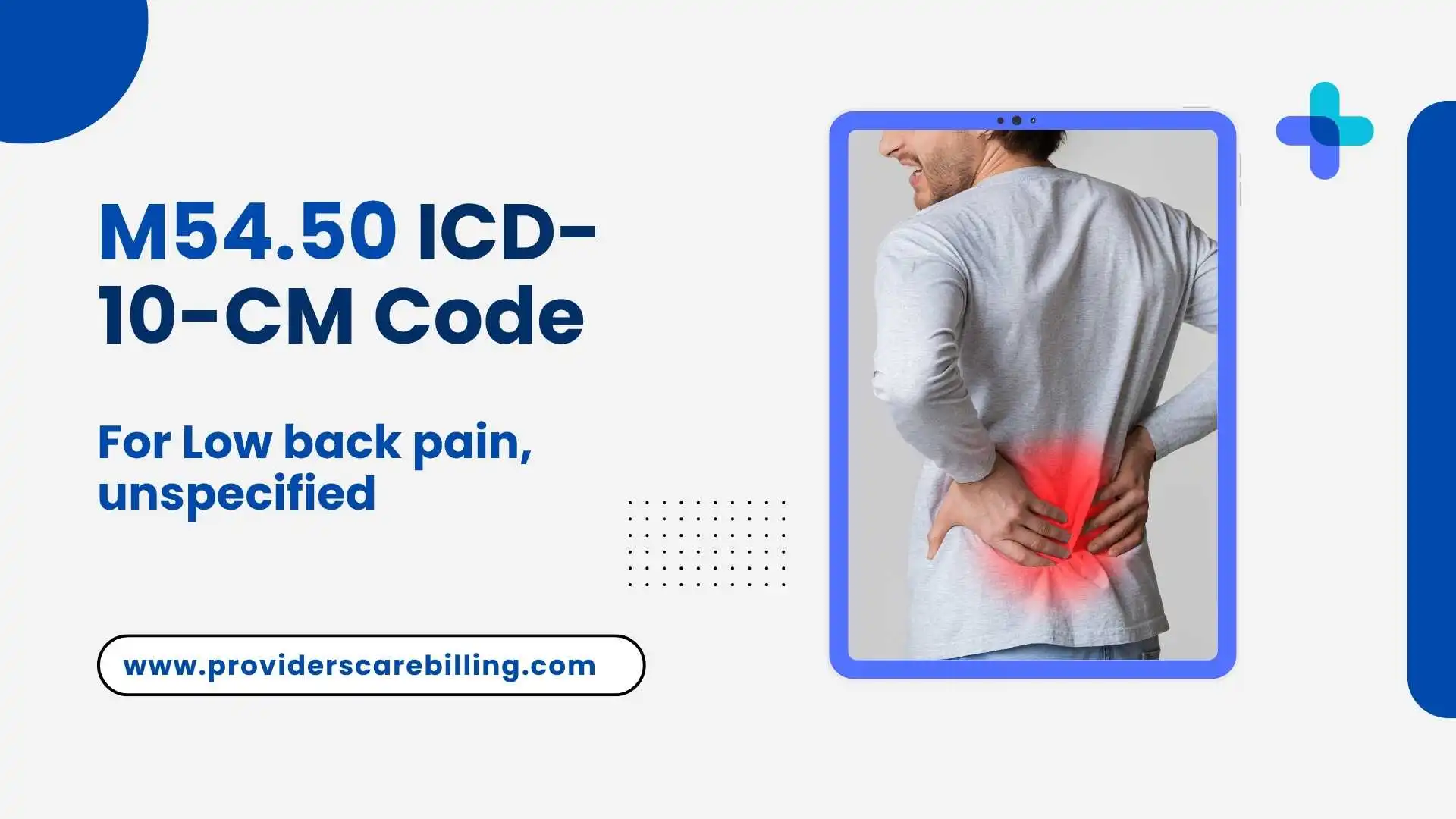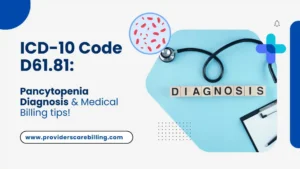Do you know that over 80 percent of the entire population of people living in the United States will experience low back pain at some point in their lives?
This prevalent disease not only impacts the quality of life but also causes a considerable number of healthcare visits annually, thus becoming a priority among healthcare providers, as well as billing departments. With the ICD-10 code relating to low back pain (M54.50) being vital in achieving compliance, avoiding denials, and obtaining optimum reimbursements among medical billing professionals, it is imperative that the code is used.
Understand the Low back pain ICD 10 Code
Low back pain will be classified under ICD-10 Code M54.50 in situations where no specific diagnosis or additional information is available. It is applicable in situations where the source of low back discomfort is unknown. It is used when patients complain of low back discomfort while visiting physical therapy, pain management, and general care institutions, where diagnosing lower back pain is essential. Doctors typically utilise M54.50 to note the presence of vague low back discomfort on first visits. It enables medical professionals to record the diagnosis’s findings before certain tests or other information sources. This code makes it possible to bill insurance for low back pain evaluation, examination, and primary care.
What is ICD-10 Code M54.50?
The code can be used when a patient complains of having low back discomfort and is not actually aware of the specific aetiology or underlying condition. The code number related to the procedure is ICD-10 M54.50; it is called unspecified low back pain.
When someone experiences back pain, this phrase is often used to describe it, and it may require a specific diagnosis code. It includes additional subcategories that provide more information regarding the kind, location, and cause of the pain experienced.
Real-Life Example
One of the certified medical coders in Texas talked about her experience when claims were denied because there was inconsistent documentation. In one case, where the physician (we) entered the symptom of back pain in the note, he or she failed to reference the specific diagnosis code or how long it lasted. We filed M54.9, and it was denied. After we edited the clinical note and resubmitted it with the help of M54.50 and carryings, the claim has been paid completely.
The reason is that when it comes to coding chronic low back pain, knowing specific ICD-10-CM codes like M54.50 or M54.51 can either be the thing that sinks or the thing that swims your billing fortunes, as demonstrated in the practice scenario that follows.
ICD-10 Code M54.50 breakdown :
| Component | Meaning | Explanation |
| M | Disease of the musculoskeletal system | Explains that there is some relation between the illness and the musculoskeletal system, which is constituted of the connective tissues, the muscles, the bones, and the joints. |
| 54 | Dorsalgia | Shows that dorsalgia, a general term for back pain, is the issue. This covers the range of upper, middle, and lower back symptoms. |
| .5 | Lower back pain | Back discomfort is the only cause of injury, and the lumbar region of the back is primarily impacted. |
| .50 | Unspecified | This is an indicator that the actual cause of the low back pain, like lumbago, is not mentioned in the records. It is used when an accurate diagnosis has not been made or noted. |
The common indications of M54.50 Symptoms :
In mentioning M54.50, we are referring to a situation in which back pain, although it is apparently located in the lower section of the back, does not have a known cause. It is the back pain that happens unexpectedly and sometimes might be due to long-lasting sitting conditions, excessive exercising in the gym, or merely sleeping in a bad position, when people experience some discomfort in the lumbar region of the spine. Others call it a chronic pain in the back or back pain.
Also, you may experience some muscle tightness, stiffness, and therefore be unable to bend, twist, or even rest, and this may be a diagnosis of low back pain. The most important thing is that back pain, in particular chronic low back pain, often does not disappear without treatment. It might be something more specific, like sciatica, which would be a separate code entirely, if it is shooting down the legs or is accompanied by numbness or weakness.
Low back pain and urinary tract infections are among the most common reasons for outpatient visits. If you’re coding for UTIs, here’s a helpful guide to ICD-10 code N39.0 for unspecified urinary tract infections.
Related ICD-10 Variants :
| Code | Description |
| M54.5 | Lower Back Pain (general parent code) |
| M54.50 | Back Pain (unspecified) |
| M54.51 | Low back pain caused by vertebralogenic. |
| M54.9 | Back pain unspecified (Dorsalgia unspecified) |
Let us help you out in case you experience difficulty with rejected claims caused by incomplete or incorrect ICD-10 low back pain coding, particularly M54.50 for low back pain.
Visit the Contact page of Provider Care Billing LLC to understand how you can get maximum Medical Coding services and complete Revenue Cycle Management services offered to orthopedic and pain management clinics nationwide in the USA.
📞 Call Now: 888-495-3786
📧 Email: Info@providerscarebilling.com
Common Billing Mistakes :
Although it may seem to be such a straightforward one, medical coders and billers tend to commit mistakes when dealing with M54.50:
1. The Specific Diagnoses escalator with M54.50 for low back pain :
Unspecified low back pain is M54.50 and should not be utilized in an instance where the provider has documented a definite cause, such as disc herniation, sciatica, or strain of muscles; it excludes chronic conditions. In such cases, use more specific codes, such as the ICD-10-CM code for low back pain. use M54.51 or M54.59.
2. Excluded Diagnosis using ICD-10-CM code M54.50 :
As it is mentioned, M54.50 is not supposed to coincide with such codes as M54.41. Coding audits and rejected claims can be a result of double coding.
3. Inadequate Clinical Documentation :
Another common cause of inappropriate use of M54.50 is the provider documentation that is either insufficient or imprecise, leading to potential coding errors for the diagnosis code. When and where a clarification is required, a coder must ask the provider to clarify it.
Conclusion
Low back pain is among the most widely reported but often incorrectly coded diagnoses in the outpatient setting, particularly when it comes to chronic low back pain. With the convoluted nature of coding regulations in healthcare practice nowadays, proper application of ICD-10 M54.50 and related back pain codes can spell the final line between payment of the claim and denial notification.
Unlock cleaner claims and quicker payments with the assistance of Providers Care Billing LLC in unlocking your Medical Billing Services and Credentialing solutions. Whether it is back pain or bundled surgical cases, we are ready to support you with correct coding and dependable revenue, including the new codes for diagnosing lower back pain.
FAQS
Q: What is the ICD-10 code for low back pain?
M54.50 is the code for “Unspecified low back pain”.
Q: What’s the difference between M54.5 AND M54.50?
M54.5 is the parent code, M54.50 is the code used for a specified back pain.
Q: Is M54.50 billed for chronic or acute low back pain?
It can be utilized when chronicity is not mentioned. G89.29 is also considered with chronic pain.




